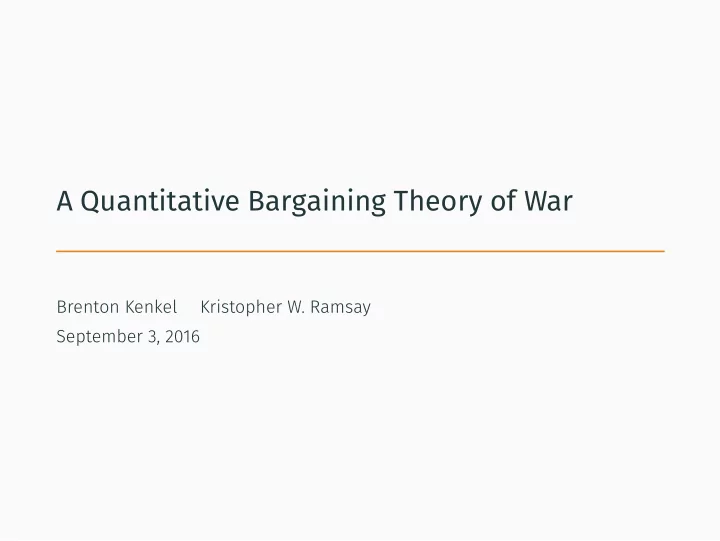

Kristopher W. Ramsay Brenton Kenkel September 3, 2016 A Quantitative Bargaining Theory of War
Key concepts in bargaining model of war: • Military strength • Resolve/cost of fighting • Prior beliefs/uncertainty How can we measure these theoretical quantities in terms of observable characteristics of states? Introduction
2. Model exogenous parameters as functions of data 1. Write down bargaining model of war 3. Assume data generated by equilibrium behavior 4. Structurally estimate Approach
2. Side B accepts or rejects Bargaining model Sides A and B , each with ≥ 1 constituent states 1. Side A offers x ∈ R • Accept → A gets x , B gets 1 − x • Reject → each pays θ k , war occurs War costs θ A , θ B i.i.d. Exponential ( λ )
c j e j c j e j War payoffs: Probability Side A wins: War-fighting model Each state expends effort e i ≥ 0 ∑ j ∈ A m j e j p A = ∑ j ∈ A m j e j + ∑ j ∈ B m j e j ∑ u A = p A − θ A − j ∈ A ∑ u B = 1 − p A − θ B − j ∈ B
• Democracy • Marginal cost of effort: c i • Imports/GDP exp W • Contiguity • Preference Similarity • Rivalry • Major Power Involvement • Peace Years exp Z i • Military effectiveness: m i exp X i • GDP • Population • Military Quality Empirical parameterization Crisis level • Shape of prior beliefs: λ State level
• Democracy exp X i • Imports/GDP exp Z i • Marginal cost of effort: c i • Military Quality • Population • GDP • Military effectiveness: m i • Peace Years • Major Power Involvement • Rivalry • Preference Similarity • Contiguity Empirical parameterization Crisis level • Shape of prior beliefs: λ = exp ( W α ) State level
• Democracy exp X i • Imports/GDP exp Z i • Marginal cost of effort: c i • Military Quality • Population • GDP • Military effectiveness: m i • Peace Years • Major Power Involvement • Rivalry • Preference Similarity • Contiguity Empirical parameterization Crisis level • Shape of prior beliefs: λ = exp ( W α ) State level
• Democracy • Military Quality • Imports/GDP • Contiguity • Preference Similarity • Rivalry • Major Power Involvement • Peace Years exp Z i • Marginal cost of effort: c i • GDP • Population Empirical parameterization Crisis level • Shape of prior beliefs: λ = exp ( W α ) State level • Military effectiveness: m i = exp ( X i β )
• Democracy • Military Quality • Imports/GDP • Contiguity • Preference Similarity • Rivalry • Major Power Involvement • Peace Years exp Z i • Marginal cost of effort: c i • GDP • Population Empirical parameterization Crisis level • Shape of prior beliefs: λ = exp ( W α ) State level • Military effectiveness: m i = exp ( X i β )
• Contiguity • Preference Similarity • Rivalry • Major Power Involvement • Peace Years • GDP • Population • Military Quality • Imports/GDP • Democracy Empirical parameterization Crisis level • Shape of prior beliefs: λ = exp ( W α ) State level • Military effectiveness: m i = exp ( X i β ) • Marginal cost of effort: c i = exp ( Z i γ )
• Contiguity • Preference Similarity • Rivalry • Major Power Involvement • Peace Years • GDP • Population • Military Quality • Imports/GDP • Democracy Empirical parameterization Crisis level • Shape of prior beliefs: λ = exp ( W α ) State level • Military effectiveness: m i = exp ( X i β ) • Marginal cost of effort: c i = exp ( Z i γ )
Militarized Interstate Disputes, 1816–2001 • War: 0 or 1 • Winner: A , B , or censored Data • N = 2 , 295 disputes, with 5 , 451 total participants
... 2 --- ---------- 1 A 0.4 6.4 1 B 7.8 3.1 2 A 0.8 5.6 A ------- 4.2 6.4 2 B 6.2 8.6 3 A 1.3 2.0 3 B 7.9 8.4 ---- ... 0 2 Contiguity Rivalry ... ------- --- ------ ---------- ------- 1 0 . 0 Population 1 War A 1 0 3 0 . 0 1 ... Dispute Dispute Side GDP Winner Data structure Crisis level State level
0.5 1.0 0.0 -0.5 -1.0 Effort Cost Mil. Effectiveness Prior Beliefs Parameter estimates α : Contiguity α : Preference Similarity α : Rivalry α : Major Power–Either α : Major Power–Both α : ln ( 1 + Peace Years ) β : ln ( GDP ) β : ln ( Population ) β : ln ( 1 + Military Quality ) γ : ln ( 1 + Import Percentage ) γ : Democracy Estimate ± 1 . 96se
0.4 0.5 0.6 0.7 1850 1900 1950 2000 Probability USA wins war Equilibrium quantities: USA vs. Russia
1.0 1.5 1850 1900 1950 2000 Optimal offer by USA Equilibrium quantities: USA vs. Russia
0.00 0.05 0.10 0.15 1850 1900 1950 2000 Probability of war Equilibrium quantities: USA vs. Russia
• Bargaining model has empirical content • No discernible effects of economic/political characteristics on states’ ability and willingness to wage war • Different variables in the effectiveness/cost equations? • Benchmark models for predictive comparison? • Other substantive applications of estimator? Conclusions and next steps Conclusions • Major powers, similar preferences → more uncertainty • Rivals, long time at peace → less uncertainty Next steps
Recommend
More recommend